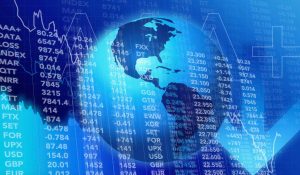
New York — World stock markets climbed on Thursday as investors weighed a rebound in oil prices and prospects for further government stimulus against stark economic data showing the toll of the coronavirus pandemic.
Investors tilted toward emerging markets from safe-haven assets like the dollar and government bonds.
Major U.S. and European stock indexes were up more than 1% in midday trading in New York on news U.S. jobless claims fell to 4.4 million, a decline from 5.2 million the week before, but still about 200,000 more than expected. A record 26 million Americans have sought unemployment benefits over the last five weeks.
“The market is ignoring all the weak data so far, it’s priced in,” said Priya Misra, head of global rates strategy for TD Securities.
“We have moved ahead from the second quarter being awful,” Misra said, adding that market participants were turning towards the outlook for the third and fourth quarters.
Oil rose, spurred by rising tensions in the Middle East and production cuts by nations aimed at stopping oversupply that caused record plunges early this week.
U.S. crude recently rose 29.61% to $17.86 per barrel and Brent was at $22.69, up 11.39% on the day.
The Dow Jones Industrial Average rose 332.47 points, or 1.42%, to 23,808.29, the S&P 500 gained 37.14 points, or 1.33%, to 2,836.45 and the Nasdaq Composite added 115.25 points, or 1.36%, to 8,610.63.
The pan-European STOXX 600 index rose 1.01% and MSCI’s gauge of stocks across the globe gained 1.18%.
The dollar index, tracking the unit against six major peers, slipped 0.328%. Benchmark 10-year U.S. Treasury notes were up and down in modest swings. The notes last rose 2/32 in price to yield 0.6125%, from 0.619% late on Wednesday.
Riskier emerging market stocks rose 0.62% and MSCI’s broadest index of Asia-Pacific shares outside Japan closed 0.51% higher, while Japan’s Nikkei rose 1.52%.
Investors were looking hopefully toward a meeting of European Union leaders who were considering their first step towards the joint financing of an economic recovery after the coronavirus pandemic.
“(The) EU Council meeting will be closely watched to see how quickly EU policy-makers will move towards area-wide fiscal risk-sharing,” said George Cole, an economist at Goldman Sachs. “We expect the discussions to fall short of a full commitment to mutualize risks from the COVID-19 shock.”
The importance of the meeting was underlined by news that a gauge of economic health, the IHS Markit’s Flash Composite Purchasing Managers’ Index (PMI) for the European Union, sank to its lowest reading since the survey began in mid-1998. In the UK, PMIs fell to a new record low in March – and far below even the weakest forecast in a Reuters poll of economists.
An internal EU note showed the bloc’s commission was considering a plan worth 2 trillion euros ($2.2 trillion) to tackle a deep recession.
The EU meeting came as the U.S. Congress appeared to be on course to approve nearly $500 billion more in coronavirus aid, taking the world’s biggest economy’s overall stimulus packages to nearly $3 trillion.



